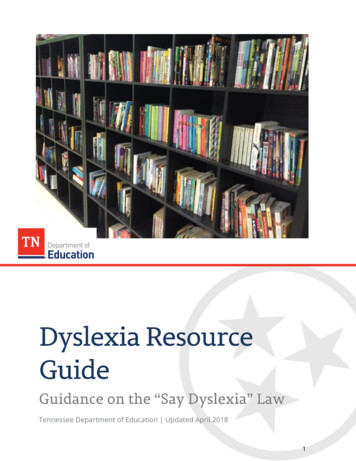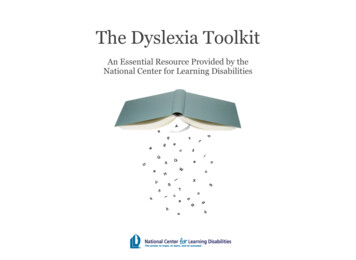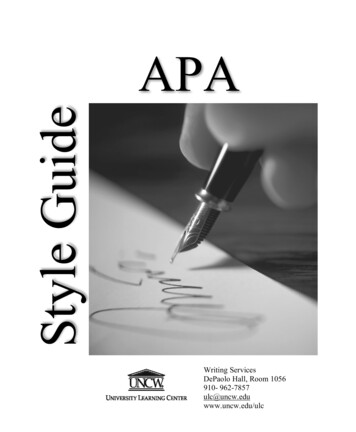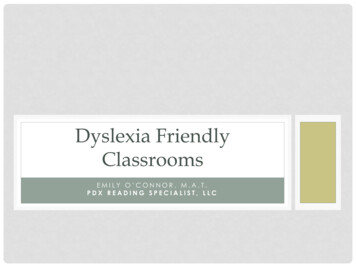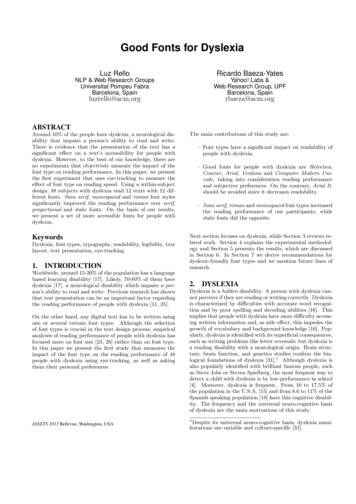
Transcription
Good Fonts for DyslexiaLuz RelloRicardo Baeza-YatesNLP & Web Research GroupsUniversitat Pompeu FabraBarcelona, SpainYahoo! Labs &Web Research Group, UPFBarcelona, Spainluzrello@acm.orgrbaeza@acm.orgABSTRACTAround 10% of the people have dyslexia, a neurological disability that impairs a person’s ability to read and write.There is evidence that the presentation of the text has asignificant effect on a text’s accessibility for people withdyslexia. However, to the best of our knowledge, there areno experiments that objectively measure the impact of thefont type on reading performance. In this paper, we presentthe first experiment that uses eye-tracking to measure theeffect of font type on reading speed. Using a within-subjectdesign, 48 subjects with dyslexia read 12 texts with 12 different fonts. Sans serif, monospaced and roman font stylessignificantly improved the reading performance over serif,proportional and italic fonts. On the basis of our results,we present a set of more accessible fonts for people withdyslexia.The main contributions of this study are:KeywordsNext section focuses on dyslexia, while Section 3 reviews related work. Section 4 explains the experimental methodology and Section 5 presents the results, which are discussedin Section 6. In Section 7 we derive recommendations fordyslexic-friendly font types and we mention future lines ofresearch.Dyslexia, font types, typography, readability, legibility, textlayout, text presentation, eye-tracking.1.INTRODUCTIONWorldwide, around 15-20% of the population has a languagebased learning disability [17]. Likely, 70-80% of them havedyslexia [17], a neurological disability which impairs a person’s ability to read and write. Previous research has shownthat text presentation can be an important factor regardingthe reading performance of people with dyslexia [11, 25].On the other hand, any digital text has to be written usingone or several certain font types. Although the selectionof font types is crucial in the text design process, empiricalanalyses of reading performance of people with dyslexia hasfocused more on font size [23, 26] rather than on font type.In this paper we present the first study that measures theimpact of the font type on the reading performance of 48people with dyslexia using eye-tracking, as well as askingthem their personal preferences.ASSETS 2013 Bellevue, Washington, USA– Font types have a significant impact on readability ofpeople with dyslexia.– Good fonts for people with dyslexia are Helvetica,Courier, Arial, Verdana and Computer Modern Unicode, taking into consideration reading performanceand subjective preferences. On the contrary, Arial It.should be avoided since it decreases readability.– Sans serif, roman and monospaced font types increasedthe reading performance of our participants, whileitalic fonts did the opposite.2.DYSLEXIADyslexia is a hidden disability. A person with dyslexia cannot perceive if they are reading or writing correctly. Dyslexiais characterized by difficulties with accurate word recognition and by poor spelling and decoding abilities [16]. Thisimplies that people with dyslexia have more difficulty accessing written information and, as side effect, this impedes thegrowth of vocabulary and background knowledge [16]. Popularly, dyslexia is identified with its superficial consequences,such as writing problems like letter reversals; but dyslexia isa reading disability with a neurological origin. Brain structure, brain function, and genetics studies confirm the biological foundations of dyslexia [31].1 Although dyslexia isalso popularly identified with brilliant famous people, suchas Steve Jobs or Steven Spielberg, the most frequent way todetect a child with dyslexia is by low-performance in school[4]. Moreover, dyslexia is frequent. From 10 to 17.5% ofthe population in the U.S.A. [15] and from 8.6 to 11% of theSpanish speaking population [18] have this cognitive disability. The frequency and the universal neuro-cognitive basisof dyslexia are the main motivations of this study.1Despite its universal neuro-cognitive basis, dyslexia manifestations are variable and culture-specific [31].
3.RELATED WORKThe relationship between fonts and dyslexia has drawn theattention of many fields, such as psychology, arts, and accessibility. We divide related work in: (1) fonts recommendedfor people with dyslexia, (2) fonts designed for this targetgroup, and (3) related user studies.3.1RecommendationsMost of the recommendations come from associations forpeople with dyslexia and they agree in using sans-seriffonts. The British Dyslexia Association recommends to useArial, Comic Sans or, as alternatives to these, Verdana,Tahoma, Century Gothic, and Trebuchet [2]. However, thewebsite does not disclose on the basis of which evidence theserecommendations are made. In [10] recommendations forreaders with low vision as well as readers with dyslexia areput in comparison, giving as a result the recommendation ofusing also Arial and Comic Sans. In [22] is recommended toavoid italics and fancy fonts, which are particularly difficultfor a reader with dyslexia, and also point to Arial as preferred font. Another font recommended in 2010 was SassoonPrimary but not anymore [9].The only recommendation for serif fonts has been doneby the International Dyslexia Centre [13] and that was forTimes New Roman. According to [1], Courier is easier toread by people with dyslexia because it is monospaced.In the Web Content Accessibility Guidelines (WCAG) [3],dyslexia is treated as part of a diverse group of cognitivedisabilities and they do not propose any specific guidelinesabout font types for people with dyslexia.Surprisingly, none of the typefaces recommended by thedyslexia organizations mentioned above were ever designedspecifically for readers with dyslexia.3.2Fonts Designed for People with DyslexiaWe found four fonts designed for people with dyslexia: Sylexiad [12], Dyslexie [21], Read Regular,2 and OpenDyslexic.3The four fonts have in common that the letters are moredifferentiated compared to regular fonts. For example, theshape of the letter ‘b’ is not a mirror image of ‘d’. Fromthese fonts, we choose to study Open Dyslexic (both romanand italic styles), because it is the only open sourced andhence free. This font has been already integrated in varioustools.3.3User StudiesThere are several uses studies on text presentation and people with dyslexia regarding font and background colors [25],font [23, 26] or letter spacing [33].The closest work to ours is a study with people with dyslexia[21] that compared Arial and Dyslexie. They conducteda word-reading test with 21 students with dyslexia (DutchOne Minute Test). Dyslexie did not lead to faster reading,but could help with some dyslexic-related errors in Dutch.In [29], text design for people with dyslexia is explored witha qualitative study with just eleven students. In some exic.org/the participants needed to choose the font they prefer, butno analyses of the chosen fonts is presented.3.4What is Missing?What is missing is an objective investigation into the effect ofthe most frequent fonts on reading performance. Our experiment advances previous work by providing this evidence viaquantitative data from eye-tracking measurements. In addition, with testing 12 different fonts with 48 participants,we compare a greater number of font types with a largernumber of participants than previous studies. We selectedthe fonts on the basis of their popularity and frequency ofuse in the Web.4.METHODOLOGYTo study the effect of font type on readability and comprehensibility of texts on the screen, we conducted an experiment where 48 participants with dyslexia had to read12 comparable texts with varying font types. Readabilityand comprehensibility were analyzed via eye-tracking andcomprehension tests, respectively, using the latter as a control variable. The participants’ preference was gathered viaquestionnaires.4.1DesignIn our experimental design, Font Type served as an independent variable with 12 levels: Arial, Arial Italic, Computer Modern Unicode (CMU), Courier, Garamond, Helvetica, Myriad, OpenDyslexic, OpenDyslexic Italic, Times,Times Italic, and Verdana (See Figure 1). We use for brevityOpenDys for the corresponding fonts in the rest of the paper.This is ArialThis is Arial It.This is Computer ModernThis is MyriadThis is CourierThis is GaramondThis is HelveticaThis is TimesThis is OpenDyslexicThis is OpenDyslexic It.This is Times It.This is VerdanaFigure 1: Fonts used in the experiment.We chose to study Arial and Times because they are themost common fonts used on screen and printed texts, respectively [5]. OpenDyslexic was selected because is a freefont type designed specifically for people with dyslexia andVerdana because is the recommended font for this targetgroup [2]. We choose Courier because is the most commonexample of monospaced font [5]. Helvetica and Myriad werechosen for being broadly used in graphic design and for beingthe typeface of choice of Microsoft and Apple, respectively.We chose Garamond because is claimed to have strong legibility for printed materials [5] and we selected CMU becauseis widely used in scientific publishing, as is the default of thetypesetting program TeX, as well as a free font supportingmany languages [20].
We also made sure that the fonts cover variations of essentialfont characteristics:– Italics served as independent variable with two values:italic denotes the condition where the text was presented using an italic type, that is a cursive typeface,and roman denotes the condition when the text waspresented in a roman type. We study the italic typesof Arial, OpenDyslexic, and Times.– Serif served as independent variable with two values:serif denotes the condition where the text was presented with typefaces with serifs, small lines trailingfrom the edges of letters and symbols, and sans serifdenotes the condition when the text used typefaceswithout serifs. In our set of fonts there are three seriffonts –CMU, Garamond, and Times– and four sansserif fonts –Arial, Helvetica, Myriad, and Verdana–.– Monospace served as independent variable with twovalues: monospaced denotes the condition where thetext was presented using a monospaced type, that is, afont whose letters and characters each occupy the sameamount of horizontal space, and proportional, wherethe text was presented using proportional fonts. Wechose the most commonly used monospaced font, theroman serif font Courier, and we compare it with therest of the roman and serif fonts that are proportional:CMU, Garamond and Times.a control variable to guarantee that the recordings analyzedin this study were valid. If the reader did not chose the correct answer, the corresponding text was discarded from theanalysis.Preference Ratings: In addition, we asked the participants to provide their personal preferences. For each of thetwelve text-font pairs, the participants rated on a five-pointLikert scale, how much did they like the font type used inthe text presentation.We used a within-subject design, that is, each participantread 12 different texts with 12 different fonts, hence, contributing to each condition. We counter-balanced texts andfonts to avoid sequence effects. Therefore, the data withrespect to text-font combinations was evenly distributed.4.2ParticipantsWe had 48 people (22 female, 26 male) with a confirmeddiagnosis of dyslexia taking part in the study. Their agesranged from 11 to 50 (x̄ 20.96, s 9.98) and they allhad normal vision. All of them presented official clinicalresults to prove that dyslexia was diagnosed in an authorized center or hospital.4 Except from 3 participants, allof the participants were attending school or high school (26participants), or they were studying or had already finisheduniversity degrees (19 participants). We discarded the eyetracking recordings that had less then the 75% of the samplerecorded, hence, 46 out of the 48 recordings were valid.For quantifying readability, we used two dependent measures: Reading Time and Fixation duration, both extractedfrom the eye-tracking data. To control text comprehensionof the texts we use one comprehension question as a control variable. To collect the participant preferences, we usedsubjective Preference Ratings through questionnaires.4.3Reading Time: Shorter reading durations are preferred tolonger ones since faster reading is related to more readabletexts [32]. Therefore, we use Reading Time, i.e. the time ittakes a participant to completely read one text, as a measureof readability, in addition to Fixation Duration.All the texts used in the experiment meet the comparabilityrequirements because they all share the parameters commonly used to compute readability [8]. All the texts wereextracted from the same book, Impostores (Impostors), byLucas Sánchez [28]. We chose this book because its structure (32 chapters) gave us the possibility of extracting similar texts. Each chapter of the book is an independent storyand it starts always by an introductory paragraph. Thus, wewent through the book and selected the introduction paragraphs sharing the following characteristics:Fixation Duration: We used fixation duration as an objective approximation of readability. When reading a text,the eye does not move contiguously over the text, but alternates saccades and visual fixations, that is, jumps in shortsteps and rests on parts of the text. Fixation duration denotes how long the eye rests still on a single place of the textand we use the mean of the fixation durations obtained bythe eye-tracker. Fixation duration has been shown to be avalid indicator of readability. According to [24, 14], shorterfixations are associated with better readability, while longerfixations can indicate that processing loads are greater. Onthe other hand, it is not directly proportional to readingtime as some people may fixate more often in or near thesame piece of text (re-reading).To check that the text was not only read, but also understood, we used literal questions, that is, questions that canbe answered straight from the text. We used multiple-choicequestions with three possible choices: one correct choice, andtwo wrong choices. We use this comprehension question asMaterialsTo isolate the effects of the text presentation, the texts themselves need to be comparable in complexity. In this section,we describe how we designed the texts that were used asstudy material.4.3.1Texts(a) Same genre and same style.(b) Same number of words (60 words). If the paragraphdid not had that number of words we slightly modifiedit to match the number of words.(c) Similar word length, with an average length rangingfrom 4.92 to 5.87 letters.(d) Absence of numerical expressions, acronyms, and foreign words, because people with dyslexia specially encounter problems with such words [27, 7].4In the Catalonian protocol of dyslexia diagnosis [6], thedifferent kinds of dyslexia, extensively found in literature,are not considered.
El texto habla de: ‘The text is about:’– Un sueño. ‘A dream.’– Un parque de atracciones. ‘An amusement park.’– Un helado de chocolate. ‘A chocolate ice cream.’Figure 2: Comprehension control question example.4.3.2Text PresentationSince the presentation of the text has an effect on the reading speed of people with dyslexia [11], we used the samelayout for all the texts. They were left-justified, using a 14points font size, and the column width did not exceeded 70characters/column, as recommended by the British Association of Dyslexia [2]. The color used was the most frequentlyused in the Web for text: black text on white background.4.3.3Comprehension Control QuestionsAfter each text there was one literal comprehension controlquestion. The order of the correct answer was counterbalanced. An example of one of these questions is given inFigure 2. The difficulty of the questions chosen was similar.4.4EquipmentThe eye-tracker we used was the Tobii 1750 [30], which has a17-inch TFT monitor with a resolution of 1024 768 pixels.The time measurements of the eye-tracker have a precisionof 0.02 seconds. Hence, all time values are given with an accuracy of two decimals. The eye-tracker was calibrated individually for each participant and the light focus was alwaysin the same position. The distance between the participantand the eye-tracker was constant (approximately 60 cm. or24 in.) and controlled by using a fixed chair.4.5ProcedureThe sessions were conducted at the Universitat PompeuFabra and lasted around 20 minutes. Each session tookplace in a quiet room, where only the interviewer (first author) was present, so that the participants could concentrate. Each participant performed the following three steps.First, we began with a questionnaire that was designed tocollect demographic information. Second, the participantswere given specific instructions. They were asked to read the12 texts in silence and complete the comprehension controlquestions after each text. In answering the question theycould not look back on the text. The reading was recordedby the eye-tracker. Finally, each participant was asked toprovide his/her preference ratings.5.5.1.1Font TypeTable 1 shows the main statistical measures5 for the ReadingTime and Fixation Duration for each of the Font Type conditions. Reading Time and Fixation Duration had a Pearsoncorrelation of 0.67 and p 0.001. This is as expected, recalling that reading time is the most relevant measure.Reading Time: There was a significant effect of Font Typeon Reading Time (χ2 (11) 31.55, p 0.001) (Figure 3).The results of the post-hoc tests show that:– Arial It. had the longest reading time mean. Participants had significantly longer reading times usingArial It. than Arial (p 0.011), CMU (p 0.011),and Helvetica (p 0.034).Fixation Duration: There was a significant effect of FontType on Fixation Duration (χ2 (11) 93.63, p 0.001) (Figure 4). The results of the post-hoc tests show that:– Courier has the lowest fixation duration mean. Participants had significantly shorter fixation durationsreading with Courier than with Arial It. (p 0.001),CMU (p 0.001), Garamond (p 0.001), Times It.(p 0.001), OpenDys It. (p 0.001), and Arial(p 0.046).– Helvetica has the third lowest fixation duration mean.Participants had significantly shorter fixation durations reading with Helvetica than with Arial It. (p 0.001) CMU (p 0.001), and Garamond (p 0.006).– Participants had significantly shorter fixation durations reading with Arial than with CMU (p 0.020).– Arial It. had the highest fixation duration mean.Participants had significantly longer fixation durationsreading with Arial It. than with Courier (p 0.001),Helvetica (p 0.001), Arial (p 0.001), Times It.(p 0.001), Times (p 0.003), Myriad (p 0.004),Garamond (p 0.011), and Verdana (p 0.049).RESULTSIn this section, we present the reading performance resultsand the preference ratings.5.1with a Bonferroni correction that includes the adjustmentof the significance level. To study the effect of the secondlevel independent variables, Italics, Serif, and Monospace,we use a Wilcoxon test. For these reasons we later includethe median and box plots for all our measures in additionto the average and the standard deviation. All this analysiswas done using the R statistical software.Reading PerformanceA Shapiro-Wilk test showed that nine and eight out of thetwelve data sets were not normally distributed for the Reading Time and Fixation Duration, respectively. Also, a Levene test showed that none of the data sets had an homogeneous variance for both measures. Hence, to study significant effects of Font Type in readability we used the Friedman’s non-parametric test for repeated measures plus a complete pairwise Wilcoxon rank sum post-hoc comparison testSummarizing, Courier lead to significant shorter fixationsdurations than six other fonts and Arial It. lead to significant longer fixations durations than eight other fonts. Infact, 16 out of the 66 pairwise comparisons were significant.5.1.2ItalicsReading Time: We did not find a significant effect of Italics on Reading Time (W 4556, p 0.09). The visit duration means were x̄ 32.35 seconds (x̃ 28.77, s 14.62)5We use x̄ for the mean, x̃ for the median, and s for thestandard deviation.
8080 6060 4040 2020ReadingTime Mean(seconds)Visit Duration(ms) Font Typea ArialArialb OpenDysOpenDysc CMUCMUd CourierOpenDys It.f HelveticaCourierHelveticag VerdanaVerdana h TimesTimes i TimesTimesIt.It. j MyriadMyriad k GaramondGaramond l ArialArialIt.It.Figure 3: Reading Time box plots by Font Type orderedFontbyNameaverage Reading Time. (Lower reading times indicatebetter readability.)0.50.5 0.40.4 0.20.20.30.3 0.10.1FixationDuration Mean(ms)FixationDuration(seconds) Font Typea ArialArialb OpenDysOpenDysc CMUCMUd Courier OpenDys It.f HelveticaCourierHelveticag VerdanaVerdana h TimesTimes i TimesTimesIt.It. j MyriadMyriad k GaramondGaramond l ArialArialIt.It.Figure 4: Fixation Duration box plots by Font Type orderedby average Reading Time. (Lower fixation durationsFont Nameindicate better readability.)Font TypeArialOpenDysCMUCourierOpenDys It.HelveticaVerdanaTimesTimes It.MyriadGaramondArial 526.9530.5329.68Reading Timex̄ s28.35 12.3929.17 15.7929.58 12.0529.61 10.8729.68 14.4431.05 15.0431.16 13.0331.68 11.8132.38 12.3432.66 14.8033.30 15.4534.99 16.60Font rdanaHelveticaArialTimesMyriadTimes It.OpenDysOpenDys It.GaramondCMUArial It.Fixation Durationx̃x̄ s0.22 0.22 0.050.22 0.23 0.070.24 0.24 0.060.23 0.24 0.070.24 0.25 0.070.25 0.25 0.070.25 0.26 0.060.24 0.26 0.070.26 0.26 0.070.25 0.27 0.070.25 0.27 0.080.28 0.28 0.08Font l It.Times It.GaramondOpenDysOpenDys It.Preferences Ratingx̃x̄ s43.79 0.9843.62 1.0843.60 1.1343.45 1.153.53.40 0.9933.31 0.9833.14 1.3932.90 1.1032.86 1.2022.57 1.1532.57 1.1522.43 1.27Table 1: Median, mean and standard deviation of Reading Time and Fixation Duration in seconds as well as themedian, mean, and standard deviation of the Preference Ratings. We include the relative percentage for ReadingTime, our main readability measure, with respect to the smallest average value, Arial.
and x̄ 29.74 seconds (x̃ 27.04, s 13.40) for the fontsin italic and in roman, respectively.Fixation Duration: There was a significant effect of Italics on Fixation Duration (W 8297.5, p 0.040). Infact, the fixation duration mean of the fonts in italics (Arial It., OpenDys. It., and Times It.), x̄ 0.27 seconds(x̃ 0.26, s 0.08), was significantly larger than the fixation duration mean of the fonts in roman (Arial, OpenDysand Times), x̄ 0.25 seconds (x̃ 0.24, s 0.07).5.1.3There was a significant effect of Font Type on subjectivepreference ratings (χ2 (11) 79.6119, p 0.001). Pairwisepost-hoc comparisons showed significant differences betweenthe following conditions:– Verdana is significantly preferred over Arial It (p 0.001), OpenDys (p 0.002), OpenDys It. (p 0.004),Garamond (p 0.008), and Times It. (p 0.041).– Helvetica is significantly preferred over OpenDys It.(p 0.010), OpenDys (p 0.020), and Arial It.(p 0.031).Serif– Arial was significantly more preferred than Arial It.(p 0.028) and OpenDys It. (p 0.050).Reading Time: We did not find a significant effect of Serifon Reading Time (W 11852, p 0.2021). The visitduration means were x̄ 31.53 seconds (x̃ 29.06, s 13.21) and x̄ 30.80 seconds (x̃ 27.08, s 13.83) for theserif fonts and sans serif font types, respectively.Fixation Duration: There was a significant effect of Serifon Fixation Duration (W 10547.5, p 0.008). Indeed,the fixation duration mean of the fonts with serif, x̄ 0.26seconds (x̃ 0.25, s 0.07), was significantly larger thanthe fixation duration mean of the fonts sans serif, x̄ 0.24seconds (x̃ 0.24, s 0.07).5.1.4MonospaceReading Time: We did not find a significant effect ofMonospace on Reading Time (W 3589.5, p 0.159). Thevisit duration means were x̄ 29.61 seconds (x̃ 29.73, s 10.87) and x̄ 31.53 seconds (x̃ 29.06, s 13.20) for themonospaced fonts and the proportional fonts, respectively.Fixation Duration: There was a significant difference ofMonospace on Fixation Duration (W 4251.5, p 0.001).We found that the fixation duration mean of the monospacedfont, x̄ 0.22 seconds (x̃ 0.22, s 0.05), was significantlyshorter than the fixation duration mean of the proportionalfonts, x̄ 0.26 seconds (x̃ 0.25, s 0.07).5.2Preferences RatingsA Shapiro-Wilk test showed that the twelve data sets werenot normally distributed for the Preference Ratings. Also, aLevene test showed that none of the data sets had an homogeneous variance. Hence, to study the effect of Font Typein the preferences we use the same analysis of the previoussection.5.2.1Font TypeFigure 5 shows the means of the Preference Ratings for eachof the Font Types and in Table 1 we show the main statisticalmeasures for the participants preferences.Preference Ratings and Reading Time had a Pearson correlation of -0.13, negative as expected (Table 1). However isclose to 0, which implies that there is almost no correlationbetween the reading time and the participants preferences.– Garamond was significantly less preferred than Verdana (p 0.008), Times (p 0.023), Arial (p 0.023), and CMU (p 0.030).Hence, participants significantly preferred Verdana and Helvetica to other fonts and significantly disliked Garamond incomparison with others.5.2.2Fonts SubsetsWe did not find a significant difference of Italics on the participants preferences (W 2747.5, p 1). The preferenceratings mean of the fonts in italics was x̄ 3.73 seconds(x̃ 3, s 1.20) and for the fonts in roman was x̄ 3.21seconds (x̃ 3, s 1.22).We did not find a significant effect of Serif on the participants preferences (W 13030.5, p 0.999). The preferenceratings mean of the fonts with serif was x̄ 3.05 seconds(x̃ 3, s 1.17) and for the fonts with sans serif wasx̄ 3.46 seconds (x̃ 4, s 1.17).We did not find a significant effect of Monospace on theparticipants preferences (W 2574.5, p 0.789). Thepreference ratings means were x̄ 3.13 seconds (x̃ 3, s 1.19) and x̄ 33.14 seconds (x̃ 3, s 1.39) for themonospaced and the proportional fonts, respectively.6.DISCUSSIONFirst, our results on reading performance provide evidencethat font types have an impact on readability. Second, theseresults are consistent with most of the current text designrecommendations for people with dyslexia. Fonts sans serifand in roman style, lead to shorter fixation durations in ourparticipants, as recommended in [22]. However, these stylesdid not lead to significant shorter reading durations.Overall, the reading time of the italic fonts was always worsethan its roman counterpart, confirming the commonly established fact that cursive letters are harder to read for peoplewith dyslexia. Although sans serif, monospaced and romanfonts lead to significant shorter fixation durations, we didnot find a significant difference in reading time. Hence, ourconclusions towards these characteristics are weaker.Although Arial is highly recommended in literature [2, 10,22] and had the shortest reading time, we cannot conclude
331122PreferencesPreferences4455 Font TypeAriala Arial OpenDysb OpenDysCMUc CMU CourierHelveticag VerdanaVerdana h TimesTimes i TimesTimesIt.It. j MyriadMyriad k GaramondGaramond l ArialArialIt.It.d CourierOpenDys It.f HelveticaFigure 5: Subjective Preference Ratings box plots dependingFont Nameon the Font Type (by average Reading Time order).a)ArialHelveticaOpenDyslexic CMUVerdanab)ArialHelveticaCMUArial It.Timesc)MyriadCourierOpenDyslexic ItTimes It.Arial c ItTimes It.ArialArial It.CMUTimesGaramondFigure 6: Partial order obtained from the means order of Reading Time and Preference Ratings (a), and thepartial order for the significant differences in Reading Time (b) and Preference Ratings (c).that this font type leads to better readability because weonly found significant differences with respect to OpenDysIt. and Arial It. However, Arial It. did lead to significantlonger reading times than Helvetica, Arial, and CMU andsignificant longer fixation durations than most of the fonts.Hence, we recommend to avoid using Arial It. Moreover,participants significantly preferred Arial to Arial It.The two fonts that lead to shorter fixation durations thanother fonts were Courier and Helvetica. Hence the use ofthese fonts might help people with dyslexia to read faster.This is consistent with the recommendation of [1] to useCourier and with [22] to use sans serif fonts in the case ofHelvetica. Also, Helvetica was the second most significantlypreferred font by our participants after Verdana.The fonts designed specifically for dyslexia, OpenDys andOpenDys It., did not lead to a better or worse readability. Asin [21], OpenDys did not lead to a faster reading. However,we did not performed a reading out loud test with words,which is what might improve with the use of specially designed fonts [21]. In addition, our participants significantlypreferred Verdana or Helvetica for reading than OpenDysand OpenDys It.One way to understand these results is to build the partialorder obtained by considering all the order relations that arevalid for the average values in Reading Time and the Prefer-ence Ratings. The result is given in Figure 6 (a), where thefonts can be grouped in four different levels. However, notall of these order relations are significant. Hence, the partialorders at the right, (b) and (c), show the significant relationsfor Readi
hence free. This font has been already integrated in various tools. 3.3 User Studies There are several uses studies on text presentation and peo-ple with dyslexia regarding font and background colors [25], font [23, 26] or letter spacing [33]. The closest work to ours is a study with people with dyslexia [21] that compared Arial and Dyslexie.
